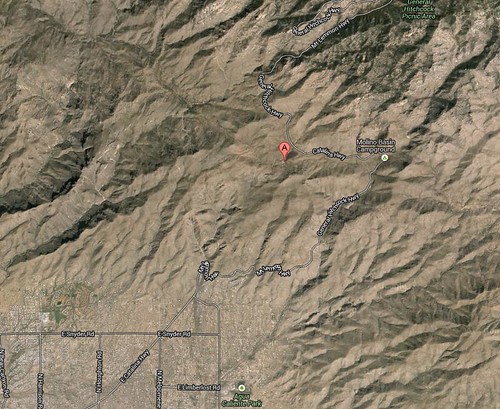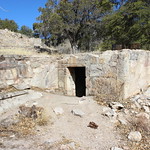“Remember the couple from England who were here last month? I took them on a hike to the ruins of the Japanese internment camp on Mount Lemmon.”
“There was a Japanese internment camp on Mount Lemmon?”
That’s how the conversation went, me being the dummy who didn’t know about the camp. I’ve lived at the foot of Mount Lemmon since 1998, have driven the Catalina Highway to the top at least a hundred times, and had never heard of any such camp. But the minute my friend mentioned it, things began to click. Yes, the highway had been built with convict labor, overseen by an Army general named Hitchcock. Ipso facto, there must have been a prison camp on the mountain. To be sure, there are dirt roads branching off the highway, one named Soldier Camp Trail, one named Prison Camp Trail. There’s a General Hitchcock Campground. And there’s a sign for the Gordon Hirabayashi Recreation Area. Gordon Hirabayashi? Sounds vaguely Japanese, right?
I did some digging. There were two Japanese internment camps in Arizona, one near Poston on the western side of the state, and one near Sacaton, halfway between Casa Grande and Phoenix. Approximately 31,000 Americans of Japanese descent were imprisoned in the Arizona camps during World War II. There wasn’t one anywhere near Tucson, though.
Kids of my generation didn’t learn about the mass internment of Japanese Americans during WWII until we were in college, if then. It was almost as if our teachers were ashamed to tell us what their generation had done. Concentration camps in America? Yes, we had ’em.
Here’s the quick & dirty (click here if you want to learn more): in 1942, shortly after the Japanese attack on Pearl Harbor and the start of WWII, President Roosevelt signed an executive order authorizing the internment of people of Japanese descent living on the West Coast. Some were first generation Japanese immigrants, not yet American citizens, but most were American citizens, second- and third-generation descendants who had lived here all their lives. Approximately 110,000 people of Japanese descent were rounded up, forced to sell their property and possessions at short notice, and transported to wartime relocation camps in the western US. Americans of German descent, I was shocked to learn, were not given similar treatment.
If the prison camp on Mount Lemmon wasn’t a Japanese internment camp, what was it? It was a federal minimum-security prison, built in 1939. Convicts housed in the camp, which was named the Catalina Federal Honor Camp, were the laborers who built the Catalina Highway, a 26-mile road from northeastern Tucson to the top of Mount Lemon. In the 1960s the facility was transferred to the state of Arizona, renamed the Catalina Honor Camp, and was used to house juvenile offenders until the 1970s, when it was decommissioned and razed.

Though the Catalina Federal Honor Camp was not one of the Japanese internment camps set up under Roosevelt’s executive order, it did house some Japanese American prisoners during WWII, and that’s the connection with the man named Gordon Hirabayashi. Hirabayashi was a second-generation American citizen of Japanese descent who protested the wartime internment of Japanese Americans and was arrested for it. He was imprisoned in the camp along with 45 other Japanese Americans who were convicted of resisting the wartime draft. Hmmm … being interned for being part Japanese and then arrested for resisting the draft seems like double jeopardy to me, but what do I know?
Hirabayashi’s case went all the way to the top, and in 1943 the Supreme Court ruled against him, finding the wartime internment of Japanese Americans legal. His wartime conviction was finally overturned in 1987, and in 1999 the old prison camp was renamed in his honor.
Once I’d satisfied my curiosity about the history and purpose of the prison camp on Mount Lemmon, there was just one thing left to do: hop on the motorcycle and take a look at it myself. Here are some photos of the remains of the prison camp, along with one of me bundled up for my February ride up the mountain, taken at Geology Point, a couple of thousand feet above the prison camp site (click on the thumbnails to see the large originals on Flickr):
 |
 |
 |
 |
 |
 |